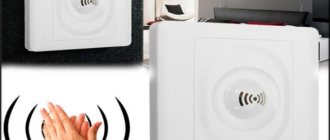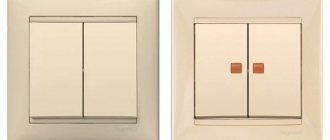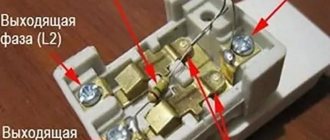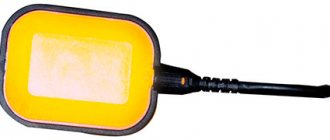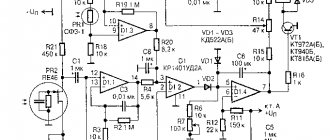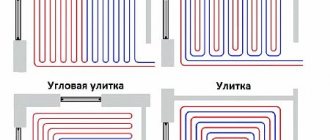A sound sensor is a functional device, the main purpose of which is to turn on lighting in rooms where it is not very convenient to look for a switch. Turning on the light by clapping may not be the only ability of such a device, unlike the initial stage of its appearance, when they were used only in security systems. Today, the range offered to consumers includes simple devices that respond to any noise source, recognize a specific sound, and even expensive devices programmed to perform several functions at once.
- What it is
- The main purpose of the device
- Principle of operation
- Light on cotton
- Principle of operation
- Types of acoustic sensors
- Scope of application
- Device and design
- Criterias of choice
- Video: how to assemble a cotton switch sensor with your own hands
- Diagram - how to connect the sensor to a light bulb
Turning off the light with a clap: benefits and advantages
The high-tech device closes and opens an electrical circuit when a sound signal is given, such as clapping your hands.
It is capable of remotely controlling not only the lights in the house, but also other electrical appliances: a fan, a humidifier, a stereo system, equipment, and aquarium lighting. This useful device replaces or duplicates the traditional switch/remote control, saving users time on actions. All electrical consumers located in the acoustic sensitivity zone of the device can be equipped with acoustic switches.
Types of sound switches
Acoustic switches can respond to voice commands and claps
The following types of acoustic switches exist:
- Devices that react to cotton. It is programmed in advance at what number of claps a particular command will be executed.
- Devices that respond to voice or a preset command.
- Combined devices (for example, light-acoustic switch). They can be equipped with sound, light or motion sensors. These are the most technologically advanced devices in which the risk of false alarms is minimized.
- Devices for low-current systems. Used to connect a video camera or transmit a command to security.
Acoustic switches have become popular due to their ease of use. They are useful for the elderly, bedridden patients and young children. Devices of this class are already actively used in the Smart Home system.
Advantages and disadvantages
The most important advantage of a sound switch over classic ones is its simplicity and ease of use.
The user does not need to think about where to install the switch. Main advantages:
- work with any electrical appliances or light sources;
- the ability to turn on and off a household appliance or light from anywhere in the room;
- no extra wires;
- reliability and long service life;
- noiselessness;
- safety.
Flaws:
- Modern sensors can recognize the sound that is needed to turn it on and off. The user needs to know exactly what signal the sensor will respond to.
- The sensitivity area is limited. In a large room you will have to clap loudly or move closer to the sensor. If you increase the sensitivity, the sensor may falsely respond to similar sounds.
For radio amateurs who want to make a clap switch with their own hands, the disadvantage is the complexity of the electronic circuit.
In a transistor housing
The switch in a transistor housing is placed in a plastic box with a degree of protection from dust and moisture ≥ IP30. Thanks to the use of printed circuit boards with an SMD element base, a piezoelectric sensor and a solid-state relay, the dimensions of a modern acoustic switch in a transistor housing do not exceed the dimensions of a matchbox.
Transistor devices are successfully localized in low-current networks (alarms, video surveillance, etc.).
Without housing
The use of a product without a housing is justified if the user intends to integrate the product into the housing of some electrical appliance. For example, it involves fixing a printed circuit board with components and an acoustic sensor under the air conditioner casing or in a fan stand. An open assembly is more compact and noticeably cheaper than a device in a case.
Switches and lamps "plug-socket"
A plug-socket switch is a removable electrical installation product in a plastic case with an input plug for connection to the network. The product is equipped with 1-3 output sockets for connecting floor lamps, sconces, complex household appliances, equipment, gadgets and other energy consumers. The product is an adapter for the path of electric current from a 220 V network to the load, equipped with a sound control board.
The usual docking of a plug-socket switch allows you to connect a module with an acoustic sensor without electrical installation work.
It’s very easy to insert 1–4 switches into the room’s fixed sockets and configure them for different consumers (or groups of consumers for devices with “double” or “tee” type outputs). For example, the 1st switch will connect↔disconnect the power socket with 3 claps, the 2nd will operate with 4 claps, the 3rd will respond with 5 claps, the 4th will control 6 claps.
The acoustic switch built into the “plug-socket” is triggered by clapping your hands thanks to selective filtering, highlighting characteristic sounds from background noise.
Differences between clap and sound (voice) switch
Voice control devices are more complex than slam switches. They use special active filters on microcircuits that perform the functions of a command decoder. They recognize a sequence of vowel sounds of a certain frequency and duration, ignoring acoustic interference.
Device and design
The simplest circuit consists of just a few parts - as a standard, it is a set of two acoustic relays and a trigger, assembled into a single whole on one transistor. The authors of homemade sensors claim that a simpler scheme than this does not exist in nature. Options include those assembled on a printed circuit board, with a power supply. Sometimes a breadboard is used, and the battery voltage varies from 9 to 12 units. It will be turned on and off by clapping your hands.
The technical parameters of devices manufactured in industrial environments may differ in load power, sound intensity, and even the use of alternative mains voltage. Belarusian Ecosvet X-300-L operates from sound in the range from 30 to 300 decibels, including a standard set of parts and a durable box. This is the most affordable device in terms of cost, after making it yourself, and only because a radio amateur at home can find suitable parts that do not have to be specially purchased.
Tip: Before you begin installing a homemade or purchased sensor, you need to check it for compliance with the specified parameters. The use of a clap switch can be considered satisfactory if it does not respond to any sounds other than clapping your hands. if this cannot be done even after careful adjustment, it means that the components of the sound switch are selected or connected incorrectly.
Slam switch testing
Before connecting it, you need to configure the device for the presence of extraneous sounds. After this, you need to configure the device to trigger from extraneous sounds:
- From a hammer.
- The phone rings.
- Perforator work.
- Clattering of dishes.
After this, it is necessary to provoke false alarms of the device. After conducting all the experiments, you need to draw conclusions. If your device does not respond to extraneous sounds, then it works fine.
Clap switch - light on clap
-0%
-0%
Claps switch "CLAPS MAX" - reliable light control from clapping
from 2,470 rub. for 1 piece
More details
More details
-0%
-0%
Claps switch “CLAPS MAX Free” - light controlled by clapping
from 2,370 rub. for 1 piece
More details
More details
-25%
-25%
Cotton light switches “CLAPS MAX X4” – 4 pieces per set
from 7,410 rub. for 1 set RUB 9,880
More details
More details
-25%
-25%
Cotton light switches “CLAPS MAX Free X4” – 4 pieces per set
from 7,110 rub. for 1 set RUB 9,480
More details
More details
-0%
-0%
Cotton switch "CLAPS EXT" - multi-outlet extension cord
from 3,850 rub. for 1 piece
More details
More details
-0%
-0%
Cotton switch “CLAPS PLUG” - quick and convenient connection
RUB 3,970
Product sold out, out of stock!
In this section you can buy a real cotton switch
“CLAPS”, turning the light on and off with a clap! High-quality “CLAPS” clap switches respond even to quiet hand clapping, reliably turn the lighting on and off based on clapping, but do not respond to various extraneous sounds at all!
Sometimes buyers are looking for a ready-made chandelier or table lamp that could be switched on by cotton, but finding and buying such products is not very easy. But this is not the biggest problem - whoever searches will sooner or later find what he needs, as we know. But the problem is that such a lamp will be equipped with a Chinese cotton switch, which can be called a cotton switch only conditionally, since it will be triggered by any sufficiently loud sounds that it will “hear” in the room. This is why most people who have managed to buy such a lamp or chandelier will tell you that the cotton switch
- this is complete nonsense, which cannot be used at all, and they will be absolutely right in their opinion. There is only one BUT! These people know nothing about the fact that for several years now modern cotton switches “CLAPS” have been produced, which do their job amazingly clearly and reliably. Just a few years ago, nothing like this existed at all. Try it and see!
Our store presents different types of cotton switches, all of them have the same (in principle) electronic filling and completely identical control software of the built-in microprocessor. The differences between them are only in the type and appearance of the cases, which allow the use of cotton switches to solve different problems.
Now you don’t need a remote switch with a control panel - this is the last century, the remote control is constantly lost, gets dirty, and the batteries in it need to be changed. It is easier and more convenient to install a modern cotton switch
. If you have been thinking for a long time about where to buy a high-quality acoustic sensor to turn on the light by clapping, dream of purchasing a chandelier or lamp that turns on the light by clapping, or don’t know how to turn the light on and off by clapping with your own hands, then you have found exactly what you need here , what you were looking for. The “CLAPS” switch can be added to absolutely any chandelier or any other electrical appliance to turn the load on and off with ordinary clapping.
Application: relevance
A cotton switch is indispensable in cluttered (with poor natural light) rooms where it is difficult to get to or find electrical fittings on the wall.
Sound devices are especially in demand when organizing lighting/equipping electrical control systems for various storage facilities, warehouses and utility rooms.
Acoustic switches in residential areas
Sound devices are installed in the basements of buildings, vestibules and storage rooms of private houses/apartments. The remote control is useful in a children's room: in order to turn off the lights, children no longer need to move a chair or ask their parents for help. A cotton switch is indispensable for people with disabilities: there will be no need to resort to the services of relatives.
Specifications
Typical technical characteristics of an acoustic device for use in a residential building:
- net weight (without packaging) 30 – 60 g;
- overall dimensions 40*40*15 –86 *86 *26 mm;
- household voltage 220 V;
- maximum load current 5A;
- load power 200–1100 W;
- sound sensitivity adjustment 20–150 dB;
- housing protection class IP30 – IP34;
- relative humidity from 20% to 60%;
- operating temperature from 0°C to +40°C;
- Product warranty period is 12–24 months.
Interfloor space lighting
In the entrance (on the landing) of a house, it is justified to install an acoustic module with the lights turned off after a configurable period of time. The option is implemented by integrating an additional node into the circuit: a chain with a time delay on the chip (timer).
The device responds to the sound signal produced by residents and visitors to the house: the creaking of an opening door, clapping of hands, conversation and footsteps. After triggering, the lighting of the interfloor space is turned on, for example, for 5 minutes. This time is enough to open or ring the doorbell. In case of time pressure, an additional clap will update the time delay.
Scope of application
The feasibility of installing an acoustic device has long been appreciated both in the domestic aspect and on an industrial scale. One of the arguments in favor of sound sensors is extending the life of light sources, which, unlike simple incandescent lamps, are not inexpensive. Installing a simple or home-made device is cheaper than replacing burnt out light bulbs, paying for electricity by meter, and the cost of over-consumption.
You can use sound sensors:
- in distant rooms (rooms, storage rooms, warehouses, closed verandas), where people do not enter often, especially in winter;
- in functional rooms of medical buildings or production, where the switch is not used due to dirty hands or safety reasons;
- in passages (gateways, corridors of public buildings - offices, business centers, government institutions);
- in garages, operating rooms, and other rooms where installing a standard switch is in principle impossible.
Turning on the light by clap in living rooms, toilets, bathrooms and kitchens is not very popular. Much more often it is used in the corridor, where the lights are turned off after a person has undressed and gone to another place. For example, when a person is sitting on the toilet, he can be in a calm state, and then the device, without picking up noise from movement, will automatically turn off the lighting.
Principle of operation
A primitive model of an acoustic device that can be assembled by hanging installation with a test light and an 8-volt power source. The following are used:
- powerful direct bipolar transistor type KT818, or foreign analogues,
- push-pull microphone amplifier,
- a regular microphone (for example, from a tape recorder or headphones)
Such an acoustic switch device allows you to clearly trace the mechanism of converting a noise signal into an electrical one. The microphone receives the wave signal and transmits it to the amplifiers, after which a transistor is triggered through the base of the switch, starting the current connection.
Options and features
- Standard product. It is connected to a simple electrical circuit in parallel with the light switch of the device and is adjusted to the desired audio range.
- Combination with timer. Electricity is supplied to the circuit for a certain period of time after receiving the command.
- With an intellectual component. A product of complex design is capable of distinguishing incoming signals and activating a specific device.
- For low current systems. It is used in alarms, to activate cameras, microphones, and provide information to security panels.
It is necessary to think about the installation location in advance. When using a mechanical switch, our homemade switch does not participate in the operation.
Assembly option
The circuit of a simple acoustic switch with a power supply of 4.5-12 volts, and with an operating range at a distance of 2-3 m, is assembled on a printed circuit board or breadboard and consists of a larger number of parts.
Such devices are also called “clap” devices; their functional feature is sequential switching off and switching off with a sharp sound signal, similar to the clapping of palms.
The KT818 transistor connected to a relay with a 9-volt power coil is responsible for the power part.
The sensitivity of the electret microphone is set by a 10 kOhm power resistor and a 0.1 μF capacitor. It can be adjusted based on the resistance of the resistor and the capacitance of the capacitor, and through the use of more sensitive transistors. The resistor value can start from 2 kOhm, depending on the power supplied to the circuit.
Next are two amplification stages with bipolar transistors KT315 (you can use imported analogues, for example 2N5551). Resistance values can be varied by 50%. For an electromagnetic relay, you need to install a protective diode. Silicon 1N4148 or 1N401 is suitable for this function. To indicate the operation of the circuit, an LED can be installed in the power section.
How to assemble?
To make miracle technology yourself, you need the following skills and knowledge:
- on reading simple electrical circuits;
- experience with a soldering iron;
- ability to understand electrical and radio components;
- practice in the manufacture of printed circuit boards.
The switch will operate at 9 volts. A rectangular battery is suitable as a power source, but it can be replaced with a battery. When using a step-down transformer or DC-DC converter, you can operate from a 220 W network.
If you don't have the skills or qualifications, it's best not to try to do it yourself. For such people, there is a huge selection of ready-made options.
Parts List
Resistors:
- R1– 10K;
- R2– 1M;
- R3– 22K;
- R5– 2K;
- R6– 1.8K;
- R7– 330 Ohm;
- R8– 1.5K.
Transistors:
- VT1–KT315;
- VT2–RT315;
- V3– 3107 (DC557).
Capacitors:
- C1– 2200 pF;
- C2– 1 µF*10V.
Diode - VD1– 1N.
Miscellaneous:
- M1 - electrical chip;
- HL1 – LED or relay;
- contact block.
If a relay is used as a load, then resistor R8 must be changed to 2 Ohms.
Electrical diagram
There are many options on the Internet of varying complexity depending on the configuration, but not all of them are functional. Defects appear during manufacturing. The presented electrical circuit has been tested in practice.
Here VD1 is intended to protect transistor VT3. To use the relay, a diode must be installed. If you decide to install a light load, we recommend replacing the diode with a jumper.
Step-by-step instruction
The acoustic module itself is glued with tape from the inside to the chandelier or the body of an electrical appliance; connections are easier to make with Wago-type terminal blocks:
- de-energize the network, break the power circuit going to the key switch, remove the insulation and strip the ends of the wire;
- a pair of white wires from the acoustic module are connected to the phase and neutral coming from the shield or junction box;
- The two remaining black wires are similarly connected to the terminals of a lamp or household appliance.
All that remains is to move the button of the conventional switch to the “on” position, the system is ready for operation.
Varieties of acoustic switches and circuits for DIY assembly
If you are a fan of non-standard ideas for the home, then you have heard about an acoustic switch and probably wanted to buy it or make it yourself. The finished device is expensive and often of poor quality. How to make such a miracle technique yourself without spending a lot of money and time? This article describes in detail how to make a switch, provides connection diagrams and corresponding explanations.
Ecolight switch
The Ecosvet device is designed to work with 220 Volt light bulbs.
Main parameters of the device:
- load - 300 Watt;
- sound signal spread - from 30 to 150 decibels;
- housing protection level - IP30;
- permissible temperature range - from 20 degrees below zero to 40 degrees above zero;
- cost - from 350 rubles.
“Ekosvet” is fixed with self-tapping screws using the mounting legs. It is not recommended to install the device in noisy rooms. Despite the fact that “Ekosvet” is configured to clap, false alarms are possible.
The figure above shows the device connection diagram. "Ecolight" is connected to a conventional switch to provide the ability to de-energize the circuit and stop its operation.
"Claps" switch
This model is one of the latest developments, where the audio signal is processed by an advanced microprocessor. The device only responds to claps, so it ignores false information. A prerequisite for operation is a certain nature of sound transmission, when the claps must occur in a row.
Manufacturers
The most famous models presented on the Russian market are “Ecosvet” and “Claps”. Let's look at their main characteristics.
Ecolight switch
The Ecosvet device is designed to work with 220 Volt light bulbs.
Main parameters of the device:
- load - 300 Watt;
- sound signal spread - from 30 to 150 decibels;
- housing protection level - IP30;
- permissible temperature range - from 20 degrees below zero to 40 degrees above zero;
- cost - from 350 rubles.
“Ekosvet” is fixed with self-tapping screws using the mounting legs. It is not recommended to install the device in noisy rooms. Despite the fact that “Ekosvet” is configured to clap, false alarms are possible.
The figure above shows the device connection diagram. "Ecolight" is connected to a conventional switch to provide the ability to de-energize the circuit and stop its operation.
"Claps" switch
This model is one of the latest developments, where the audio signal is processed by an advanced microprocessor. The device only responds to claps, so it ignores false information. A prerequisite for operation is a certain nature of sound transmission, when the claps must occur in a row.
There may be one or more switches in one room. Each of them will be set to a given number of claps. To do this, place a jumper on the board in the desired position. As a result, it becomes possible to control several devices that are unrelated to each other, for example, an air conditioner and a lamp, a TV and a tape recorder. “Claps” is compact (about the size of a box of matches) and can be mounted anywhere, including in a socket box.
“Claps” costs more than “Ekosvet” (2450 rubles versus 350), but its reliability is higher. “Claps” will work with fluorescent light bulbs even when the load is switched on smoothly (“Ekosvet” is not capable of this).
Settings
The product is adjusted using two variable resistors. The goal is to achieve such a level of sensitivity that the switch does not trip when loud music, voices, or extraneous noise occur. When installing, the microphone should be pointed in the direction where the clap sound comes from.
Why is hand clapping used as a signal? When struck with the palms, a high-amplitude sound wave is generated, which is well captured by the microphone. Due to the high amplitude of the control signal, the possibility of unauthorized operation is eliminated. When used in a microcontroller circuit, you can replace the command that controls the light from clap to any sound or word. You will find all the nuances of installing a cotton switch in a separate material.
The finished product is shown in picture 1.
Using a certain word as a command causes difficulties, since it has to be pronounced with a certain intonation to obtain the desired amplitude.
In any house or apartment there are devices that are responsible for lighting - these are switches. The simple ones are keyboards, and the more complex ones can be different - touch, backlit, LED, pass-through, infrared. You can learn about all these types, as well as how they are repaired in case of breakdown, installed or replaced, in separate articles on our website.
With the knowledge gained, you will be able to make this device, which will be useful on the farm.
Types of acoustic sensors
A careful examination reveals that all acoustic sensors, with their inherent diversity, can be conditionally divided into three large groups. Although, looking through the assortment of special stores with similar equipment, you can easily fall into error and decide that there are many more varieties:
- For a small apartment or a relatively small functional room, standard sensors are purchased. These are devices that respond only to sound. The simplest one will turn on from any sound or noise, but they are gradually going out of everyday life, due to the high level of errors caused by groundless anxiety. The cotton one is triggered by reference noise, which is included in the general programming of the device - errors in determining the object and unnecessary turning on of the light in this case are eliminated by the design device. The clap light can be replaced by any other characteristic noise of sufficient intensity.
- Optical-acoustic sensors are an advanced system that uses not only the captured noise, but also the overall light level. These devices have a built-in photocell that blocks the light from turning on during the daytime. This makes it possible to save energy. The principle of operation of an acoustic dimmer switch also allows you to analyze the noise and level of illumination of the surrounding space, but instead of turning it off completely, it dims artificial lighting if the lack of noise signals that no one needs bright light.
- The third type of sound sensor, combined with a motion sensor, has also become less popular. It responds to noise and turns on the light when it detects the movements of living creatures. in a summer cottage or garden plot, retail space and production facilities, the use of such a device leads to constant switching on of the light if cats, dogs, field rodents and night birds fly around the perimeter.
Did you know? The scope of application of the standard sensor and other varieties is very wide, although non-advanced users may think that their main purpose is to save energy. A specialist can immediately list a dozen industries and areas where acoustic devices are used.
Criterias of choice
Before you acquire such a device, you need to determine for what purposes it is needed. On the staircase, in the courtyard and entrance, you can install the most common acoustic sensor that responds to any noise from the surrounding area. This option will allow a person climbing stairs or crossing a darkened area to reach their destination without fear of a blackout. If you install a relay that turns off after a certain period of time, an elderly or slow-walking person will find himself in the dark. The shutdown delay can be adjusted if it is provided by the manufacturer, or design changes can be made to an already purchased device.
There are other requirements for devices of a certain type:
- the street sensor must be reliably strengthened and equipped with protection from natural influences (this is especially important in regions with problematic climates;
- if the purpose of the purchase is to save lighting, it is better to purchase a model equipped with a photo relay
- the principle of operation of a dimmer acoustic switch is useful in a personal plot, in a country house - the lighting will turn off as soon as the external space no longer needs additional light, but it is also useful where people leave the room for a short time and return again (in the kitchen, in the production workshop ;
- the range of action is important if you plan to control a large space; for apartment conditions, the minimum indicators are sufficient.
Sometimes in reviews of such products you can find insistent assurances about the need to purchase sensors from a branded manufacturer with a proven reputation and high cost. At home, you can perfectly use homemade sensors that you assemble yourself. If you have no knowledge on this issue, you can simply buy a reliable domestic device.
What it is
The name acoustic system does not reflect everything that a modern sound sensor can do, because it reflects only the basic principle of operation - recognizing waves from sound of variable origin. And the modern advanced design can be tuned to only one type of sound, recorded as a reference one, respond to any noise, respond to commands, and perform several functions as the need arises.
The main purpose of the device
Switching the lighting on and off; it can be used on staircases of entrances where there is no elevator, in the openings of dark gateways where there is no need for constant lighting. Tuning in to the noise of footsteps, movement, the creaking of a door opening, the click of a lock being opened - all this leads to the fact that the on and off sensor first turns on the light for the person passing by, and then turns it off after a predetermined period of time.
Principle of operation
The sound switch sensor works on two basic principles. In the first case, it is needed to immediately after the sound is heard, turn on the lighting that was turned off in silence. The command sent to the relay by the noise turns on the light for a time sufficient to cover a certain distance. The sensor operates on this principle on flights of stairs, in dark areas of the yard, and on areas of land where there is no stationary lighting or there is simply no special need for it.
The second operating principle is provided by a delay relay. It allows the device to be triggered only by a certain noise - characteristic or prolonged. Such a light switching relay allows you not to waste electricity on the movement of a smaller object than a person, a pet, a rodent in a personal plot, and not to react to extraneous noise - natural or mechanical in origin.
Light on cotton
A popular type of relay that operates from a command more intense than the rustle of clothing, the sound of footsteps, or even the click of a lock being opened. The sensor may have one or two motivations - a clap turns the light on, two claps turns it off. Many specialists consider it impractical to install such an acoustic device in an apartment, especially if it works according to the first option. After a certain time has passed, the light turns off and the person again finds himself in the dark.
Interesting fact. Even many years ago, it seemed to craftsmen that it was an extremely simple task to assemble a simple switch that operated from a short but intense sound (in this case, it was a clap of the hands). A little later, it turned out to be possible to assemble a device that responds to voice commands, but its industrial versions never appeared on the market. Perhaps, after a while, it will be possible to turn on the lights, like Google, through a voice command.
